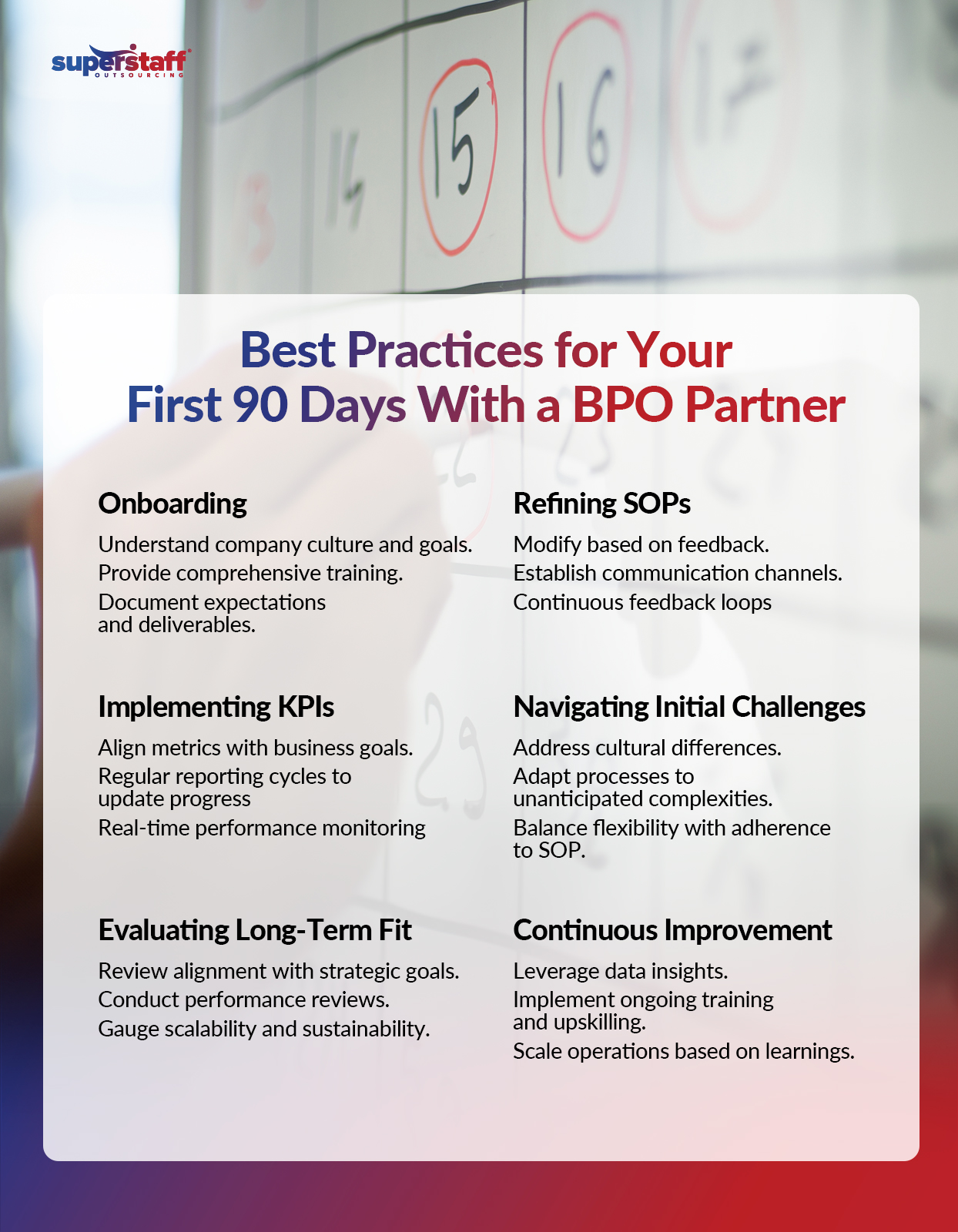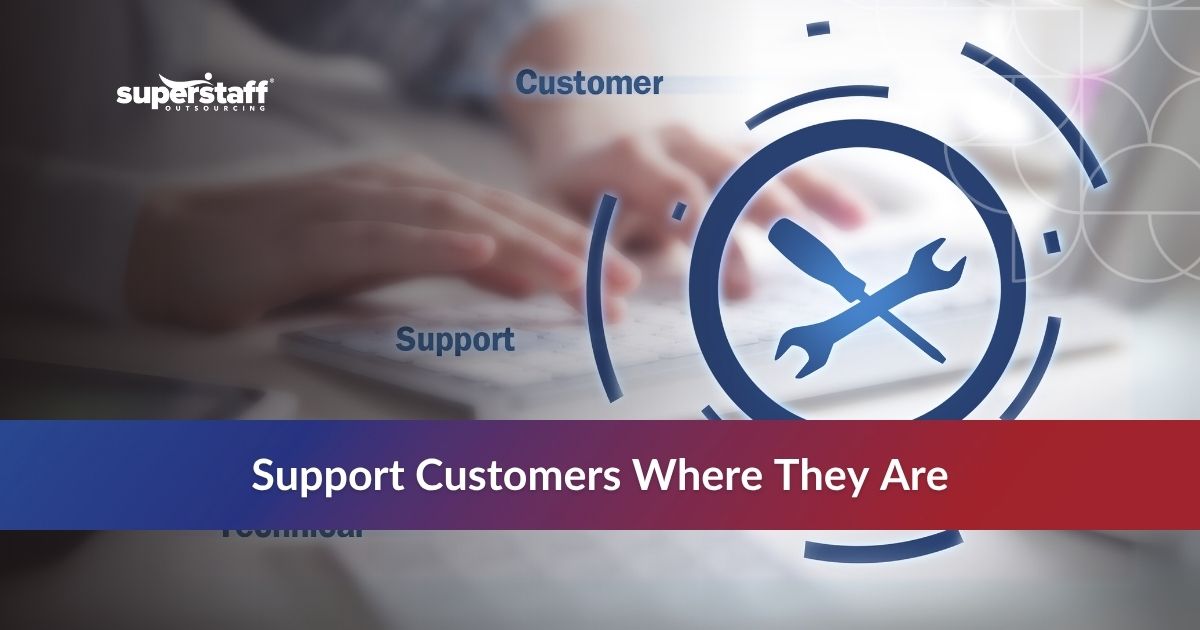
As a business leader, you know forging harmonious relationships is essential to your organization’s growth and success. Partnering with a BPO company is no different.
To make the most of your outsourcing partnership, you must create a solid foundation of trust. The first 90 days of your relationship are vital for building that foundation, starting with setting up processes, aligning expectations and goals, measuring early wins and milestones, and securing transparency and accountability.
In this article, we’ll explore the key milestones, expectations, and insights you can expect during the first 90 days with a new BPO partner. We aim to help you understand what to anticipate, how to prepare, and how to optimize your engagement with your outsourcing provider during this critical period.
The First 90 Days With a New BPO Company: Here’s What You Should Expect

The Importance of a Well-Structured Onboarding Phase
The onboarding phase is the bedrock of a successful BPO partnership. It is the time when companies and their outsourcing providers can begin understanding each other’s processes and workflows, align expectations and goals, and set the stage for mutual growth and success.
By aligning your BPO services provider with your company’s workflows, you can collaborate seamlessly, ensuring both in-house and outsourced teams are working toward a common goal. Here are the crucial components of an effective partner onboarding process:
Introduction to Company Culture, Goals, and Key Stakeholders
How does business process outsourcing work, and how will it affect your in-house operations? The onboarding stage is the ideal time to learn the answers to these questions.
Think of the onboarding process as your official introduction to your outsourcing partner. During this stage, they will learn about your products and services, company culture, and overall goals. You cannot overlook this crucial phase of your partnership because it will allow you to set expectations about how you conduct business, the standards you expect from your provider, and how you and your partner can work together seamlessly.
To maximize this introduction phase, you must also learn how your BPO partner operates. We recommend conducting a site visit to get a better feel for your offshore partner’s working culture and environment. Doing so will give you an idea of what to expect once your outsourcing partnership has officially launched and help you anticipate potential limitations or challenges and immediately address them.
Comprehensive Training and Continuous Learning
Provide comprehensive training on your company’s processes, workflows, tools, and service requirements to set your outsourced team up for success. We recommend providing a detailed brand guideline to ensure they have a document to refer to when they have questions, issues, or uncertainties. Holding a Q&A session after the main onboarding can help you clarify and address their pressing concerns.
Remember: Workflows and processes can change over time. New technological developments can be integrated into your operations, and service requirements can be tweaked to meet new regulations. So, make sure that you regularly review your training process and update your outsourcing provider on changes to ensure a smooth transition and harmonious partnership.
Documentation of Expectations and Deliverables
While it’s crucial to explain BPO expectations during your site visit or while holding training sessions, written documentation is still necessary to reduce the risk of misunderstandings and ensure all stakeholders have access to essential information.
With proper documentation, you can establish your service quality expectations and target deliverables for your offshore team. Meanwhile, your BPO partner can have an accessible document to refer to when they need a reminder of your milestones and targets.
Refining SOPs and Establishing Communication Channels
From a thorough onboarding process, the focus shifts to refining operational workflows. If the first month is the introduction phase, the second should be all about refining Standard Operating Procedures (SOPs) and optimizing communication.
Remember: Theory is different from practice. Partnerships often experience unexpected challenges or disruptions, which require process changes to address. Initial experiences during the first month will guide adjustments and workflow fine-tuning, so regular communication is necessary for any outsourcing arrangement to thrive.
Collaboration on Modifying SOPs Based on Early Performance Feedback
Standard Operating Procedures, or SOPs, are the work instructions you and your BPO partner agree on. They outline the steps needed to perform outsourced tasks and processes according to your standards and expectations.
While SOPs are negotiated early in your partnership, you’ll eventually need to reassess and refine workflows to address real-life challenges and disruptions. We recommend reviewing the data on your team’s performance and asking for direct feedback from employees so you can modify the SOP based on your team’s realistic day-to-day workload.
Establishing Clear Communication Channels Between In-House and Outsourced Teams
To ensure seamless collaboration between your in-house and outsourced teams, establish the digital communication channels and tools you’ll use early in your partnership. For instance, specify that formal concerns and problems should be documented through email, real-time communication through online chatrooms like Slack or Skype, and scheduled meetings through virtual conferencing software like Google Meet or Microsoft Teams.
Continuous Feedback Loops for Iterative Improvements
Refining SOPs is an ongoing process with room for continuous improvement throughout your partnership. As such, it’s vital to establish communication and feedback protocols and mechanisms, so your outsourced and in-house teams can share ideas, plans, and suggestions. For instance, you could designate a contact person each team member can reach out to with their urgent concerns and send out employee surveys every few months to hear everyone’s feedback.
Implementing Key Performance Indicators (KPIs) and Reporting
With processes in place, attention turns to tracking and assessing performance metrics. By the end of the third month, it is crucial to set up measurable key performance indicators (KPIs) and reporting structures. These metrics help provide a clear picture of your BPO partner’s effectiveness, including what they’re doing right and which areas have room for further improvement. Here’s how you can get started:
Identifying KPIs Aligned With Business Goals
Before starting your outsourcing partnership, you have likely identified your business goals and targets. Your BPO company’s job is to align its services and solutions with these goals, and this can be done by setting relevant KPIs and metrics for your offshore and nearshore teams.
For example, you outsourced customer service to a BPO. If your goal is to improve customer satisfaction, track your agent’s average response and resolution times. This will help you understand how quickly and effectively they handle customer inquiries, complaints, and problems. At the same time, you can send out surveys like Customer Satisfaction Score (CSAT) and Net Promoter Score (NPS) to hear from your consumers firsthand.
Establishing Regular Reporting Cycles
Tracking and evaluating your outsourced team’s performance is critical to assessing whether your provider is genuinely meeting your standards and assisting you in reaching your business goals. As such, we recommend setting regular reporting cycles so team leaders can keep you updated on their members’ progress and service quality.
During the initial stages of your partnership, more frequent updates (weekly or bi-monthly) are recommended. Once your team is well-established and you’re satisfied with their average performance, change the reporting cycle to monthly or quarterly. You can continue adjusting the reporting schedule depending on changing circumstances or your needs and goals.
Tools and Technologies for Real-Time Monitoring
Leverage the latest tools and technologies to help you keep track of your remote team. In addition to virtual communication channels, some BPOs may use time-tracking and productivity-measuring tools to collect in-depth data and insights into their team’s progress and performance.
Building Trust and Fostering Collaboration
Beyond metrics, the first 90 days are also about building strong professional relationships. Building trust is crucial during the early stages of your relationship because it helps you collaborate more effectively, share knowledge more proactively, and lay the foundation for a lasting and productive partnership.

Here’s how you can create a strong culture of trust with your BPO team:
Holding Regular Check-Ins and Progress Meetings
Trust is built through regular communication, transparency, and collaborative problem-solving. So, when partnering with a BPO company, hold regular check-ins and progress meetings. You can use this time to check on their performance, ask about their challenges (if any), address each other’s concerns, and work together to improve your processes and workflows.
Transparent Discussions on Challenges and Proactive Resolutions
Although we may try to foresee and prevent problems, unexpected challenges can still arise throughout your partnership. The best way to build trust is by being transparent about these problems and addressing them head-on as a team. While you have the final say in decision-making, giving your outsourcing team a chance to share their perspectives, ideas, and suggestions can help you create a more robust partnership built on mutual trust and respect.
Encouraging an Open Feedback Culture To Adapt Swiftly
Finally, creating a positive working environment that encourages and embraces open dialogues is critical to building trust. Giving all team members, whether in-house or outsourced, a chance to provide direct feedback and share ideas and suggestions can not only help everyone work better together but also foster creativity and innovation, which are essential to keeping your business competitive and enable you to adapt swiftly to new challenges.
Delivering Early Wins to Build Momentum
With trust established, achieving early wins becomes a focal point. Early successes lay the groundwork for long-term value and sustainable partnerships.
By reaching crucial milestones and quick wins during the first 90 days, you can more easily validate your BPO partner’s capabilities and gain measurable and meaningful results that can position your company for success in the long run. Celebrating these wins together also strengthens your client-provider relationship and builds further trust.
Identifying Areas With High Potential for Immediate Improvement
One of the best ways to achieve an early win with your BPO partner is to identify areas with potential for immediate improvement and address them together. For instance, creating a holistic and positive customer experience may be your long-term goal for your BPO team.
However, you don’t have to wait months or years to see the fruits of your labor. By expanding your customer support team, you can start making minor improvements immediately, such as speeding up issue resolution and minimizing hold times. You can see the results within the first month, comparing previous KPIs to your existing team’s performance.
Measuring and Showcasing Early Improvements in Efficiency or Cost Savings
In addition to finding areas for immediate improvement, other early wins you can celebrate with your outsourced team are enhanced efficiency and significant cost savings. Measure your overall efficiency and expenses before outsourcing and compare the results after launching your BPO team. Celebrating these wins can help you and your team forge stronger bonds, and you can use these as a confidence booster for further scaling.
Navigating Initial Challenges and Overcoming Hurdles
Early wins create positive momentum, but addressing initial challenges is also vital. During the first 90 days of your partnership, you’re bound to experience challenges that require strategic solutions.
Overcoming these hurdles together is necessary to keep your progress on the right track and position your partnership for long-term viability and sustainability. Here are some of the most common issues you may face when you start working with a BPO services provider and how you can address them effectively:
Miscommunication or Cultural Differences Impacting Workflow
Most Americans agree that diversity in the workplace is a positive thing. According to a Statista report, 72% of U.S. employees value working with diverse teams and individuals. People from different backgrounds sharing unique perspectives and ideas can foster innovation in the workplace and strengthen an organization’s competitive edge.
However, working with diverse teams can also come with its fair share of challenges. When partnering with an offshore BPO provider, one potential hurdle is navigating cultural differences and language barriers. Lack of familiarity with other teams’ cultural norms and nuances can create misunderstandings and conflicts, ultimately impacting workflow and operational efficiency.
The best way to address this is by providing cross-cultural training for your in-house and outsourced teams so they can better understand their diverse members’ working norms, communication styles, and other cultural nuances. Doing so can help you facilitate diverse thinking and ideas while encouraging all team members to engage respectfully with other people’s cultures.
Lags in Process Adaptation Due to Unanticipated Complexities
Another challenge companies may encounter when working with offshore teams is problems with adapting to set processes because of unanticipated complexities. As we mentioned above, theory is different from practice. Sometimes, a particular Standard Operating Procedure (SOP) may look seamless on paper but the workflow may need further adjustment and refinement in reality.
For example, local regulations or guidelines may prevent your outsourced team from adopting your in-house processes as-is. Sometimes, climate or weather-related disturbances can impact your offshore operations. Certain technologies, software, or tools may be unavailable or inaccessible in some locations. Once these problems present themselves, you and your BPO company can work together to address them by refining workflows to fit their local landscape. The key is to balance flexibility with adherence to SOPs.
Evaluating Long-Term Fit and Strategic Alignment
After overcoming initial challenges, evaluating long-term alignment becomes a priority. Throughout your partnership, you must continually reassess your business goals and adapt to market disruptions. As the initial 90 days conclude, this is the perfect time to evaluate your partnership’s potential sustainability and whether you can stay aligned in the long run. Here’s how:
Reviewing Alignment With Strategic Objectives and Business Values
To ensure a productive partnership, we recommend regularly reviewing your strategic objectives. Identify which of your goals can be accomplished in the near future and which require long-term planning. Then, the next step is to communicate and collaborate with your BPO partner, ensuring they align their solutions and performance with your set goals and targets.
Goals can change depending on evolving market conditions, technological advancements, and other disruptions. Securing long-term alignment means regularly keeping your outsourcing partner in the loop on your objectives and pivoting strategies when necessary.
Conducting a Performance Review To Gauge Scalability and Sustainability
In addition to regularly reviewing objectives to ensure strategic alignment, business leaders must proactively assess their BPO provider’s performance. Review company data from before you began outsourcing (including metrics like productivity, operational efficiency, and profitability) and compare them against the data after starting your BPO partnership.
Once you’ve evaluated your BPO partner’s performance, you can determine whether they met or exceeded your expectations. If you’re satisfied with their quality of work, gauge whether you can reasonably sustain or scale your outsourced operations to meet your business goals. Depending on your particular targets, you may need to renegotiate or restructure your outsourcing agreement.
Establishing a Roadmap for Continuous Improvement
A successful first 90 days can set the stage for ongoing improvement and growth. Once the partnership’s potential is confirmed, refining the roadmap ahead becomes the focus. Implementing long-term improvement initiatives ensures your partnership remains aligned, stays competitive, and thrives amid evolving conditions. Here’s how you can develop your roadmap for continuous improvement:
Developing a Continuous Improvement Plan Based on Data Insights
In today’s data-driven business landscape, leaders must make decisions based on measurable and actionable insights. One study found that 97% of executives say their companies have ignored critical data and suffered significant consequences, whether by making poor investments or missing out on new opportunities.
To capitalize on emerging trends and position your business for continuous success, you must leverage data-driven insights. Ideally, your BPO services provider can connect you with a data science specialist to help you develop your improvement initiatives using industry-wide and internal information to make comprehensive strategic recommendations.
Implementing Ongoing Training and Upskilling for the Outsourced Team
Once you’ve developed your data-driven improvement plan, you’ll need to train and upskill your workforce to ensure they can keep up with any workflow or process changes. Providing continuous learning opportunities for your outsourced team can enable them to easily understand and adapt to new developments and feel more engaged and connected with your company, leading to more positive and productive business outcomes.
Scaling Operations Based on Initial Successes and Learnings
After you’ve launched your initial improvement plans, continue monitoring and overseeing your operations. Collect as much data and information as possible to learn from all challenges and successes. Starting with a smaller team, you can gradually scale up your operations as demand increases and your workforce grows and adjusts to the improvements.
Leadership’s Role in Steering the Partnership
With continuous improvement in mind, leadership and oversight become critical enablers of success. Effective leadership is essential to maximize the value of a BPO partnership. It enhances strategic focus and alignment by overseeing multiple teams with different roles and getting them all to work toward a common goal. Here’s how strong leadership can strengthen the long-term viability of your outsourcing partnership:
Regular Involvement in Steering Meetings and Decision-Making
The success of a BPO partnership rests on a company’s strong leadership and vision. Executives make strategic decisions and steer all team members in the right direction. Without business leaders who focus on the big picture, some individual workers may get lost in the minutiae and details of their daily workload, not realizing they’ve strayed from the company’s overall vision and objectives. Strong leadership is what keeps all business activities on track to meet strategic targets and initiatives.
Clear Communication of Vision and Expectations to Both In-House and Outsourced Teams
Beyond making strategic decisions and overseeing all operations, business leaders must also be excellent communicators. When relaying instructions and assigning tasks to their teams, they must clearly communicate their vision and expectations to avoid misunderstandings, conflicts, and frustrations.
Ensuring Adaptability to Changing Business Needs and External Conditions
The business landscape is dynamic and ever-changing, so strong leadership is needed to navigate evolving market conditions, consumer preferences, and industry trends. To ensure a BPO partnership can withstand disruptions and adapt to new situations and opportunities, business leaders must be flexible enough to pivot strategically while making plans to minimize risks and maximize returns for both parties.
Ensuring Transparency and Accountability
Finally, within the first 90 days with a BPO partner, it’s crucial to establish measures that ensure transparency and accountability. These two values are the cornerstones of a long-lasting outsourcing partnership. By setting up transparent processes and robust reporting mechanisms, you can build a foundation of mutual trust while holding each other accountable for each one’s respective roles and responsibilities. Here’s how:
Establishing Clear Accountability Measures for Performance Lapses
Before launching your outsourcing arrangement, you must set clear accountability measures to avoid service quality issues and other performance lapses. You must set relevant KPIs and targets at the start of your partnership and create clear protocols for what will happen if your offshore team performs below your expectations. Some examples of policies you can put in place include Performance Improvement Plans (PIP) for individual cases and fines and penalties for widespread service failures.
Creating a Culture of Transparency Through Open Data Sharing and Regular Reporting
Meanwhile, regular communication and productive dialogues can foster transparency and openness. Encourage your in-house and outsourced teams to share knowledge and data through reporting and feedback cycles, helping facilitate greater teamwork and collaboration. These pillars of trust and transparency ultimately contribute to a long-lasting, successful partnership.
Found This Helpful? Get More In-Depth Guidance and Advice With SuperStaff
When partnering with a BPO company, the first 90 days are foundational to long-term success. You can position your outsourcing relationship for long-term success by handling training and onboarding, establishing and refining SOPs, setting relevant KPIs, and building trust, accountability, and transparency. Following the steps we shared above can help you strategically plan the first few months working with your BPO partner, helping you build a successful and enduring partnership.
If you want to read more in-depth guides on maximizing your outsourcing partnership, follow SuperStaff on LinkedIn to stay updated on our latest articles and infographics. For those ready to take their BPO journey to the next level, contact our sales team for a quick consultation!






